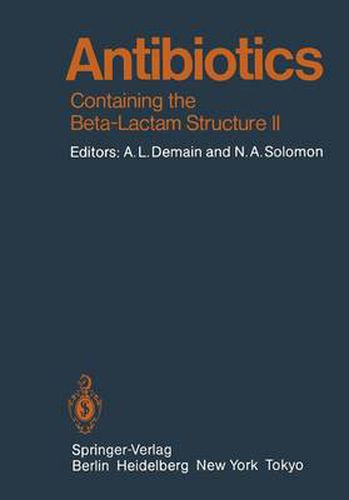Readings Newsletter
Become a Readings Member to make your shopping experience even easier.
Sign in or sign up for free!
You’re not far away from qualifying for FREE standard shipping within Australia
You’ve qualified for FREE standard shipping within Australia
The cart is loading…






This title is printed to order. This book may have been self-published. If so, we cannot guarantee the quality of the content. In the main most books will have gone through the editing process however some may not. We therefore suggest that you be aware of this before ordering this book. If in doubt check either the author or publisher’s details as we are unable to accept any returns unless they are faulty. Please contact us if you have any questions.
It is quite amazing that the oldest group of medically useful antibiotics, the fJ-Iactams, are still providing basic microbiologists, biochemists, and clinicians with surprises over 50 years after Fleming’s discovery of penicillin production by Penicillium. By the end of the 1950s, the future of the penicillins seemed doubtful as resistant strains of Staphylococcus aureus began to increase in hospital populations. However, the development of semisynthetic penicillins provided new structures with resistance to penicillinase and with broad-spectrum activity. In the 1960s, the discovery of cephalosporin C production by Cephalosporium and its conversion to valuable broad-spectrum antibiotics by semisynthetic means excited the world of chemotherapy. In the early 1970s, the 40-year-old notion that fJ-Iactams were produced only by fungi was destroyed by the discovery of cephamycin production by Streptomyces. Again this basic discovery was exploited by the deVelopment of the semisynthetic cefoxitin, which has even broader activity than earlier fJ-Iactams. Later in the 1970s came the discoveries of nocardicins from Nocardia, clavulanic acid from Streptomyces, and the carbapenems from Streptomyces. Now in the 1980s we learn that fJ-Iactams are produced even by unicellular bacteria and that semisynthetic derivatives of these monobactams may find their way into medicine. Indeed, the future of the prolific fJ-Iactam family seems brighter with each passing decade.
$9.00 standard shipping within Australia
FREE standard shipping within Australia for orders over $100.00
Express & International shipping calculated at checkout
This title is printed to order. This book may have been self-published. If so, we cannot guarantee the quality of the content. In the main most books will have gone through the editing process however some may not. We therefore suggest that you be aware of this before ordering this book. If in doubt check either the author or publisher’s details as we are unable to accept any returns unless they are faulty. Please contact us if you have any questions.
It is quite amazing that the oldest group of medically useful antibiotics, the fJ-Iactams, are still providing basic microbiologists, biochemists, and clinicians with surprises over 50 years after Fleming’s discovery of penicillin production by Penicillium. By the end of the 1950s, the future of the penicillins seemed doubtful as resistant strains of Staphylococcus aureus began to increase in hospital populations. However, the development of semisynthetic penicillins provided new structures with resistance to penicillinase and with broad-spectrum activity. In the 1960s, the discovery of cephalosporin C production by Cephalosporium and its conversion to valuable broad-spectrum antibiotics by semisynthetic means excited the world of chemotherapy. In the early 1970s, the 40-year-old notion that fJ-Iactams were produced only by fungi was destroyed by the discovery of cephamycin production by Streptomyces. Again this basic discovery was exploited by the deVelopment of the semisynthetic cefoxitin, which has even broader activity than earlier fJ-Iactams. Later in the 1970s came the discoveries of nocardicins from Nocardia, clavulanic acid from Streptomyces, and the carbapenems from Streptomyces. Now in the 1980s we learn that fJ-Iactams are produced even by unicellular bacteria and that semisynthetic derivatives of these monobactams may find their way into medicine. Indeed, the future of the prolific fJ-Iactam family seems brighter with each passing decade.